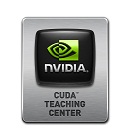Difference between revisions of "GPU610/DPS915"
(→Course Descriptions) |
(→Course Descriptions) |
||
| Line 11: | Line 11: | ||
*Modern GPU (Graphics Processing Unit) technology supports massively parallel computations, which complements the serial processing capabilities of CPU technology. This course teaches students how to read, write, and debug programs that use both CPU and GPU technology. Students learn to reorganize existing programs into serial code that runs on the CPU and parallel code that runs on the GPU. Students also study cases that have benefited from CPU+GPU programming. | *Modern GPU (Graphics Processing Unit) technology supports massively parallel computations, which complements the serial processing capabilities of CPU technology. This course teaches students how to read, write, and debug programs that use both CPU and GPU technology. Students learn to reorganize existing programs into serial code that runs on the CPU and parallel code that runs on the GPU. Students also study cases that have benefited from CPU+GPU programming. | ||
* [https://scs.senecac.on.ca/course/gpu610 Course Outline] | * [https://scs.senecac.on.ca/course/gpu610 Course Outline] | ||
| − | |||
| − | |||
| − | |||
| − | |||
| − | |||
</td> | </td> | ||
<td> | <td> | ||
| Line 22: | Line 17: | ||
</tr> | </tr> | ||
</table> | </table> | ||
| + | == DPS915 - Introduction to Parallel Programming == | ||
| + | *Modern GPU (Graphics Processing Unit) technology supports massively parallel computations, which complements the serial processing capabilities of CPU technology. This course teaches students how to read, write, and debug programs that use both CPU and GPU technology. Students learn to reorganize existing programs into serial code that runs on the CPU and parallel code that runs on the GPU. Students also study cases that have benefited from CPU+GPU programming and develop a CPU+GPU application for a client. | ||
| + | |||
| + | * [https://scs.senecac.on.ca/course/dps915 Course Outline] | ||
= Common Material = | = Common Material = | ||
Revision as of 20:03, 25 June 2012
GPU610/DPS915 | Student List | Group and Project Index | Student Resources | Glossary
Please help make this page resourceful for all GPU610/DPS915 students to use!
Contents
Course Descriptions
GPU610 - Parallel Programming Fundamentals
|
DPS915 - Introduction to Parallel Programming
- Modern GPU (Graphics Processing Unit) technology supports massively parallel computations, which complements the serial processing capabilities of CPU technology. This course teaches students how to read, write, and debug programs that use both CPU and GPU technology. Students learn to reorganize existing programs into serial code that runs on the CPU and parallel code that runs on the GPU. Students also study cases that have benefited from CPU+GPU programming and develop a CPU+GPU application for a client.
Common Material
External Links
The Project
- Under construction
Evaluation
- Assignment 30%
- Individual Work - 50%
- Group Work - 50%
- Total (Individual + Group) - 100%
- Workshops 20%
- Test 20%
- Exam 30%
Final Submission Requirements
- Under construction
Resources
- Wikis
- Subversion
